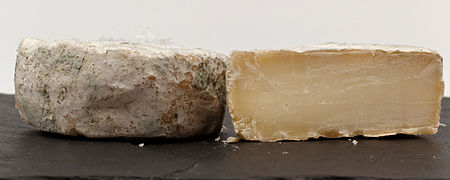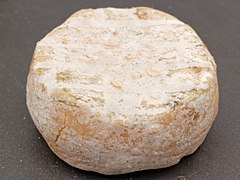Rigotte de Condrieu
Rigotte de Condrieu is a French soft cheese from the goats - raw milk . The name was derived from the former canton of Condrieu .
origin
The former canton of Condrieu belongs to the Pilat massif . The protected designation of origin PDO applies to several municipalities in the Rhône and Loire departments in the Auvergne-Rhône-Alpes region . The AOC protection status has been in place since 2009. The designation of origin has been protected since 2013.
The area is the original cantonal municipalities of Ampuis , Condrieu , Les Haies , Loire-sur-Rhône , Longes , Sainte-Colombe , Saint-Cyr-sur-le-Rhône , Saint-Romain-en-Gal , Trèves and Tupin- et-Semons in the Rhône department and today's municipality of Échalas . The urban area of Givors and Saint-Romain-en-Gier is excluded .
In the Loire department, the municipalities are: Le Bessat , Bessey , Bourg-Argental , Burdignes , La Chapelle-Villars , Châteauneuf , Chavanay , Chuyer , Colombier , Doizieux , Farnay , Graix , Lupe , Maclas , Malleval , Pavezin , Pélussin , Planfoy , Roisey , Saint-Appolinard , Sainte-Croix-en-Jarez , Saint-Julien-Molin-Molette , Saint-Michel-sur-Rhône , Saint-Paul-en-Jarez , Saint-Pierre-de-Bœuf , Saint- Sauveur-en-Rue , Tarentaise , La Terrasse-sur-Dorlay , Thélis-la-Combe , La Valla-en-Gier , Veranne , Verin , La Versanne . The urban area of Saint-Chamond and Saint-Etienne is excluded .
Surname
There are different theses for the origin.
- The name "Rigotte" is supposed to refer to the steep slopes of the Pilat massif, which are locally called "rigole" or "rigot".
- Just like the name ricotta (Italian for re-cooked), rigotte is said to be derived from the double heating of the whey or a local dialect form of “goutte” (drop).
- Rigotte is said to be the general name for cheese in the local dialect.
features
The definition of the characteristics differs depending on the time of publication. Products with a protected designation of origin are defined by law, while other forms are also described in the literature.
Non-standardized goat milk is used. However, there are restrictions on the type of feed and its origin. Mainly regionally produced green forage, grass and hay should be used. The use of silage feed and genetically modified plants is excluded.
The fat content is 40 to 50% fat i. Tr. The maturation period is at least 8 days and can be extended to 3 weeks. It has a white, ivory or bluish natural mold rind. The cheese should have a firm, smooth to creamy consistency without holes.
In contrast to cheeses made from cow's milk, molds up to 7 cm in diameter have traditionally been used. This created the typical cylindrical shape during ripening . The diameter is 4 to 5 cm. The height varies between 15 and 30 mm. The minimum weight is 30 grams. The shape should correspond to "small cheese valleys".
literature
- Marie-Anne Cantin: Guide de l'amateur de fromages. Albin Michel, Paris 2013, ISBN 978-2-226-24572-4 , p. 203.
Web links
- Cahier des charges AOC rigotte de Condrieu
- Rigotte de Condrieu , site des fromages AOP
Individual evidence
- ↑ a b Cantin 2013 , p. 203.
- ↑ Rigotte de Condrieu. Fromages AOP, accessed September 21, 2016 .
- ↑ Official Journal of the European Union L 309/7 (PDF) of November 19, 2013.
- ↑ a b Regulation EC No. 510/2006 of the Council in conjunction with Regulation 2013 / C 130/11
- ↑ Guide de fromage de france et d'Europe. Paris, Brussels, Montreal, Zurich 1995.
- ↑ Brigitte Engelmann, Peter Holler: Das Feinschmecker-Handbuch Käse. S. 188, Ullmann, Königswinter 2008, ISBN 978-3-8331-5023-4 .
- ↑ Brigitte Engelmann, Peter Holler: Das Feinschmecker-Handbuch Käse. S. 188, Ullmann, Königswinter 2008, ISBN 978-3-8331-5023-4 .




